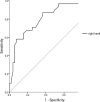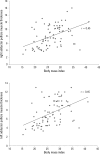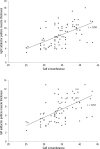Relationship between adductor pollicis muscle thickness and subjective global assessment in a cardiac intensive care unit
- PMID: 26761475
- PMCID: PMC4738823
- DOI: 10.5935/0103-507X.20150062
Relationship between adductor pollicis muscle thickness and subjective global assessment in a cardiac intensive care unit
Abstract
Objective: To verify the relationship between the adductor pollicis muscle thickness test and the subjective global assessment and to correlate it with other anthropometric methods.
Methods: This observational cross-sectional study was conducted in the intensive care unit of a cardiology hospital in the state of Rio Grande do Sul, Brazil. The hospitalized patients underwent subjective global assessment and adductor pollicis muscle thickness tests on both hands, along with measurement of the right calf circumference. Laboratory parameters, length of stay, vital signs and electronic medical record data and tests were all collected.
Results: The study population included 83 patients, of whom 62% were men. The average age was 68.6 ± 12.5 years. The most common reason for hospitalization was acute myocardial infarction (34.9%), and the most common pathology was systolic blood pressure (63.9%), followed by diabetes mellitus (28.9%). According to subjective global assessment classifications, 62.7% of patients presented no nutritional risk, 20.5% were moderately malnourished and 16.9% were severely malnourished. Women had a higher nutritional risk, according to both the subjective global assessment and the adductor pollicis muscle thickness test, the cutoff for which was < 6.5mm (54.8%; p = 0.001). The pathology presenting the greatest nutritional risk was congestive heart failure (p = 0.001). Evaluation of the receiver operating characteristic (ROC) curve between adductor pollicis muscle thickness and subjective global assessment showed the accuracy of the former, with an area of 0.822.
Conclusion: Adductor pollicis muscle thickness proved to be a good method for evaluating nutritional risk.
Objetivo: Verificar a relação do teste de espessura do músculo adutor do polegar com avaliação subjetiva global e correlacioná-lo a outros métodos antropométricos.
Métodos: Estudo transversal observacional realizado em unidade de terapia intensiva de um hospital de cardiologia no Estado do Rio Grande do Sul. Os pacientes internados foram submetidos à avaliação subjetiva global, da espessura do músculo adutor do polegar em ambas as mãos e da circunferência da panturrilha da perna direita. Foram coletados parâmetros laboratoriais, tempo de internação, sinais vitais, dados e exames do prontuário eletrônico.
Resultados: População composta de 83 pacientes, sendo 62% homens, com idade de 68,6 ± 12,5 anos. O motivo de internação mais frequente foi infarto agudo miocárdio (34,9%), e a patologia mais comum foi a hipertensão arterial sistólica (63,9%) seguida de diabetes mellitus (28,9%). Conforme a classificação da avaliação subjetiva global, 62,7% dos pacientes apresentaram-se sem risco nutricional, 20,5% moderadamente desnutridos e 16,9% gravemente desnutridos. As mulheres apresentaram maior risco nutricional, tanto pela avaliação subjetiva global quanto pela espessura do músculo adutor do polegar, que foi < 6,5mm (54,8%; p = 0,001). A patologia com maior risco nutricional foi a insuficiência cardíaca congestiva (p = 0,001). A avaliação da curva ROC entre espessura do músculo adutor do polegar e avaliação subjetiva global teve acuidade, com área de 0,822.
Conclusão: A espessura do músculo adutor do polegar demonstrou ser um bom método de avaliação de risco nutricional.
Conflict of interest statement
Figures



References
-
- World Health Organization (WHO) The top 10 causes of death. Fact sheet nº 310. [Updated May 2014]. [citado 2012 Out 10]. Disponível em:. http://www.who.int/mediacentre/factsheets/fs310/en/index2.html.
-
- Vanderwee K, Clays E, Bocquaert I, Verhaeghe S, Lardennois M, Gobert M, et al. Malnutrition and nutritional care practices in hospital wards for older people. J Adv Nurs. 2011;67(4):736–746. - PubMed
-
- Borghi R, Meale MM, Gouveia MA, França JI, Damião AO. Perfil nutricional de pacientes internados no Brasil: análise de 19.222 pacientes (Estudo BRAINS) Rev Bras Nutr Clin. 2013;28(4):253–263.
-
- Fidelix MS, Santana AF, Gomes JR. Prevalência de desnutrição hospitalar em idosos. Rev Assoc Bras Nutr. 2013;5(1):60–68.
-
- Detsky AS, McLaughlin JR, Baker JP, Johnston N, Whittaker S, Mendelson RA, et al. What is subjective global assessment of nutritional states. JPEN J Parenter Enteral Nutr. 1987;11(1):8–13. - PubMed
Publication types
MeSH terms
LinkOut - more resources
Full Text Sources

